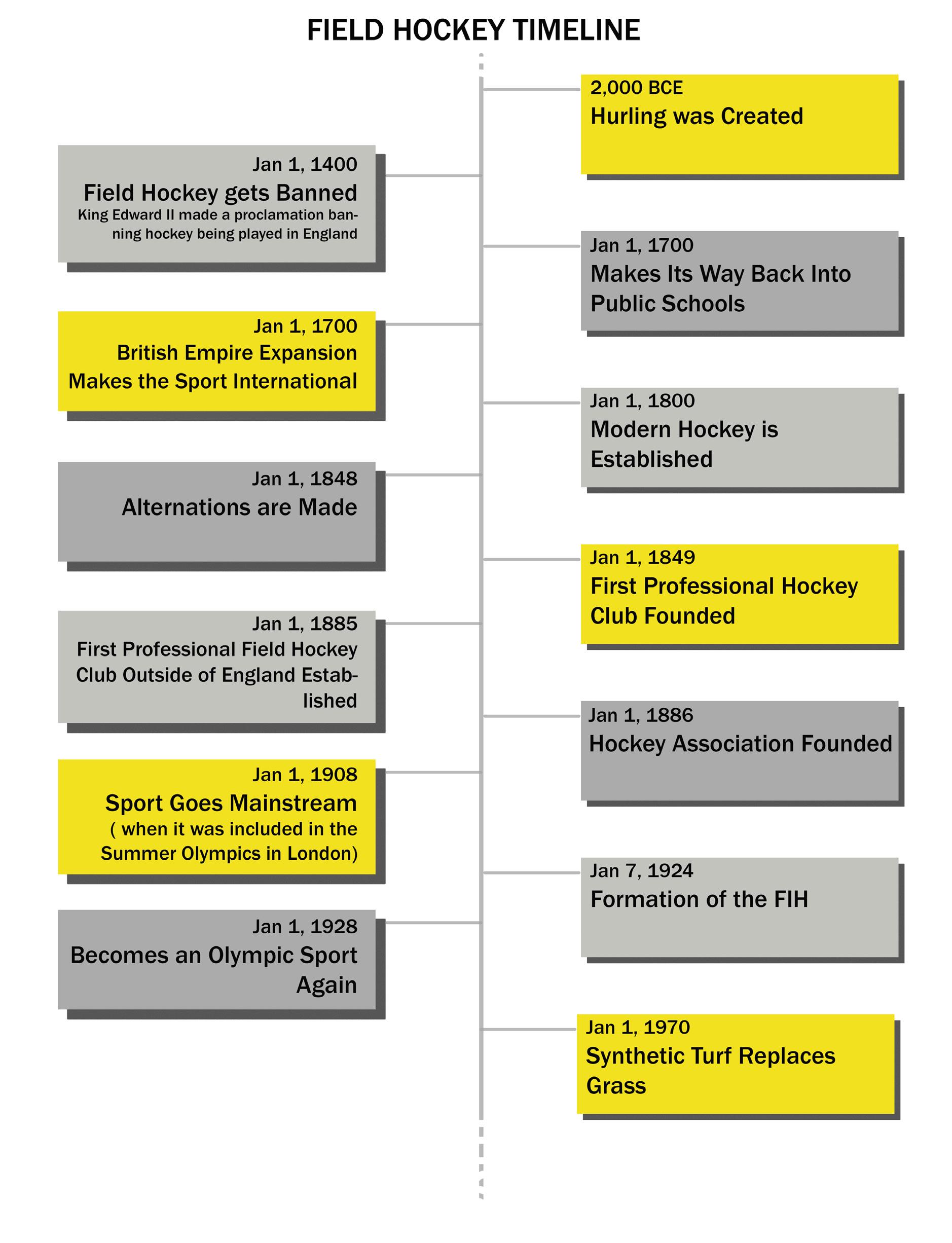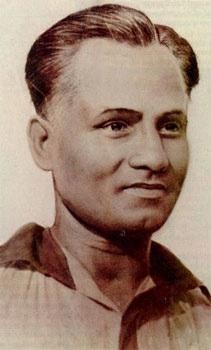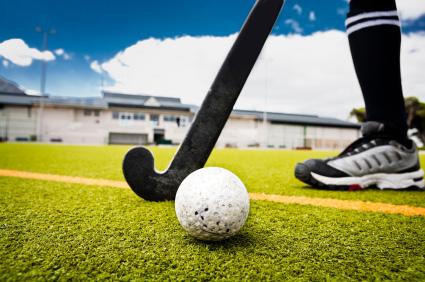
6 minute read
02 EVOLUTION OF HOCKEY
ORIGIN
Historically speaking, the origin of hockey can be traced back to 4000 years ago in Egypt. Historians point out that a crude form of the game involving sticks and a ball. Similar shreds of evidence have been found in Ethiopia around 1,000 BC and in Iran in around 2,000BC. The sport also closely resembled the modern Gaelic sport of hurling dating back nearly 3,000 years to the Greek classical era making it one of the oldest team sports in the world. The modern name “field hockey” first appeared in England in the 14th century when King Edward III issued a proclamation outlawing the practice of leisure sports by the working class. After lying dormant in England for the next several centuries, field hockey re-emerged in the post-Elizabethan British Empire and began working its way into English public schools in the 18th century. When the British Empire expanded its borders around the globe in the 1800s, the British Army brought the game of field hockey with them, expanding the sport’s practice to the point where it is now one of the most popular sports in the world. Field hockey reached its modern form in the 19th century as a game played between two teams of eleven players each. Blackheath HC (Hockey club) was founded in London in 1849 as the first professional field hockey club, but the game truly reached its modern form a few years later when Teddington HC introduced the striking circle and changed the official ball to a sphere as opposed to a rubber cube. The first Hockey Association was formed in the UK in 1876 and drew up the first formal set of rules. The original association survived for just six years but, in 1886, it was revived by nine founding member clubs. The sport went mainstream after the inaugural of Olympic Hockey Competition for men was held in London in 1908 with England, Ireland, Scotland and Wales competing separately. With the addition of Germany and France, the competition ran with six teams. After having made its first appearance at the London Games, hockey was subsequently dropped from the 1912 Stockholm Games after host nations were granted control over ‘optional sports’. It reappeared in 1920 in Antwerp after pressure from
Advertisement
Belgian hockey advocates before being omitted again in Paris in 1924. The formation of the International Hockey Federation in 1924 was not soon enough for the Paris Olympics but it did grant hockey re-entry in Amsterdam in 1928. Hockey has been on the programme ever since, with women’s hockey included for the first time in Moscow in 1980. Motivated by hockey’s omission from the 1924 Paris Games, the Fédération Internationale de Hockey sur Gazon (FIH) was founded by Paul Léautey. M. Léautey, who would later become the first president of the FIH, called together seven National Federations to form the sport’s international governing body which exists as the governing body for all international field hockey to this day. Hockey experienced its greatest level of success in British colonial India, where Calcutta HC was founded as the first professional field hockey club outside of England in 1885. The sport continued to grow at a blistering pace in India throughout the 19th and early 20th centuries, and when field hockey was reinstated as an Olympic sport in 1928, India proceeded to win the gold medal every year from 1928 to 1956.

Figure 3: Evolution Of Hockey Timeline
HOCKEY IN INDIA
Talking about hockey in India, the first hockey club came up in Calcutta in 188586 and soon Bombay and Punjab followed suit. Making its Olympic debut at the 1928 Amsterdam Games, Indian hockey team cruised home to its first Olympic gold, without conceding a single goal. The hallmark of this ruthless domination was the wizardry of Indian hockey legend - Dhyan Chand, who mesmerized the Amsterdam crowd with his dazzling skills. From 1928 to 1956, the Indian hockey juggernaut won six straight Olympic gold medals, while winning 24 consecutive matches. During this time, India scored 178 goals conceding only 7 in the process. This was the golden era of Indian hockey, when India loomed large in world hockey and produced some of the finest players the game has ever seen. During this dominance, one name that clearly comes to mind is Balbir Singh.
Figure 4: Dhyan Chand in Olymic match Figure 5: Dhyan Chand


DECLINE OF HOCKEY IN INDIA
The Indian hockey team - once an indomitable force - has suffered a rare predicament though: it has slowly but surely lost to the game itself. As the sport evolved, changing itself to woo the modern world, India stayed rooted in its past and is still paying the price. Since India’s last Olympic hockey gold in a depleted field at the Moscow Olympics in 1980, the game has time and again drawn on the support of its glorious past to garner support. Why did India lose its supremacy? - There are, of course, many reasons for this, but a major one is the constant changes in the rules of the game effected by the FIH, whose members found ways to undermine the skilful play that both India and Pakistan were famous for. Instead, the new rules put a premium on power play, with force, aerial sallies and long hard hits becoming more effective than stick-work.
FIH President Rene Frank came up with the astro-turf idea as worried Games organizers found it difficult to prepare a proper grass pitch in the wake of a severe Canadian winter. It was clear then, that synthetic pitches actually produce a whole new game, warranting a whole new approach and a whole new apparel too. So in came dress and equipment to match - the good old mulberry shaft slowly gave way to graphite and fiberglass sticks; the goalkeepers donned a Star Wars look - helmet, smock, specialized kickers and lightweight pads. . New-look hockey acquiesced to the demands of modern sport: Speed, stamina and strength replaced sublime skill, and, protective gear such as gum guards and face masks for field players too made their appearance. The ball changed from the good old seamed leather to a spheroid made of a mixture of rubber and plastic, dimpled to reduce considerably higher velocities than witnessed on natural grass. It was clear then, that synthetic pitches actually produce a whole new game, warranting a whole new approach and a whole new apparel too New-look hockey acquiesced to the demands of modern sport: Speed, stamina and strength replaced sublime skill. The gold medal win at the 1980 Moscow Olympics was the Indian Hockey team’s last major achievement in the competition. After India’s 1983 Cricket World Cup triumph, cricket overtook hockey as India’s unofficial national sport in terms of popularity. The hockey team’s performance declined over the next 3 decades. It failed to win a medal at the Olympics or the World Championships.
Figure 6: Indian cricket Team winning 1983 World Cup. Figure 7: Hockey stick and ball Illustration


NEWS ARTICLE

Figure 8: Times of India Article dated 27th Feb 2010
EVOLUTION OF THE RULES
Following are some of the rule evolution due to which the game of hockey has changed from the time India used to be on top: -
1982
NO HANDSTOP IN PENALTY CORNERS
The objective was to make penalty corners less lethal. It hasn't happened but at least new variations have emerged. India haven't learnt any new trick.
1987
PARTIAL NO OFF-SIDE RULE
Players could be offside up to the 25yard line but not beyond. Met with partial success and encouraged views to abolish it altogether.
1992
- MODIFIED OBSTRUCTION RULE - ROLLING SUBSTITUTION
Aiming to place emphasis on skill and reduce the focus on fitness - PAVING WAY FOR DRAG FLICK
1996
THE NO OFFSIDE RULE
With no restriction on movement of players, the game changed radically. It has meant more goals, fewer stoppages and a reduced burden on the umpires. A less creative midfield is the flip side.


